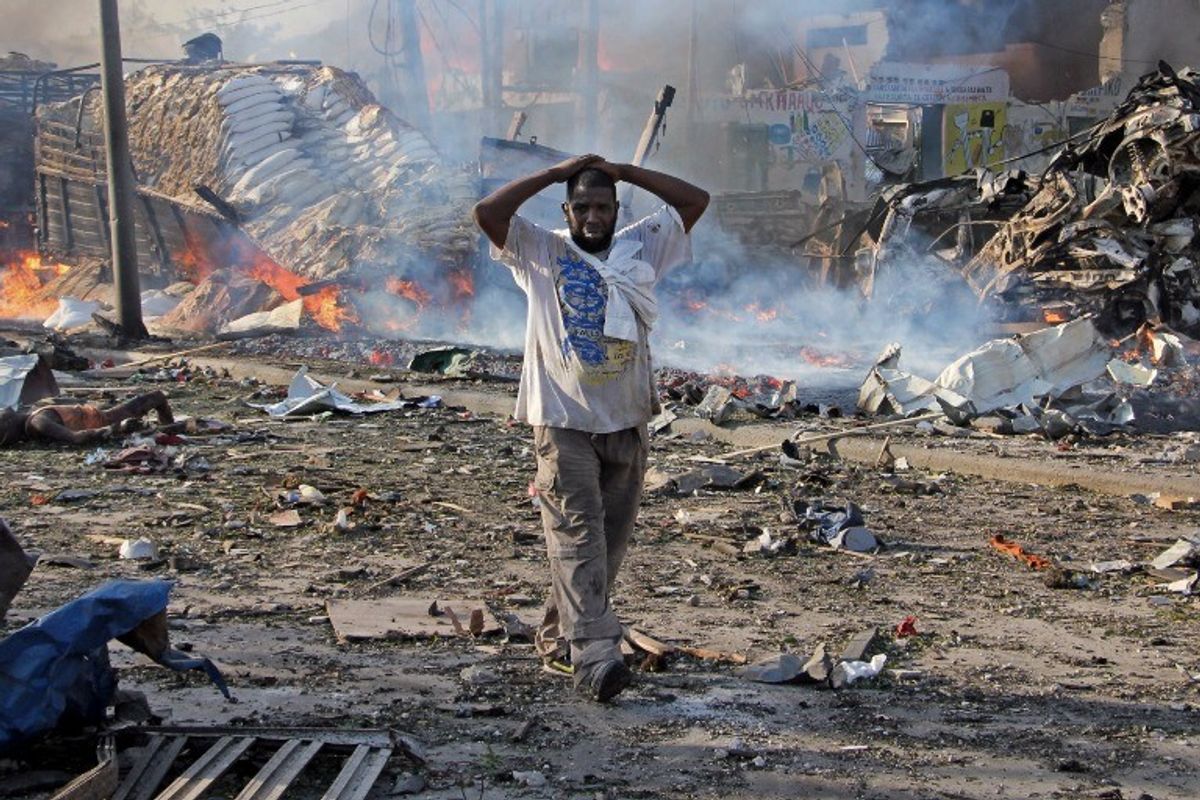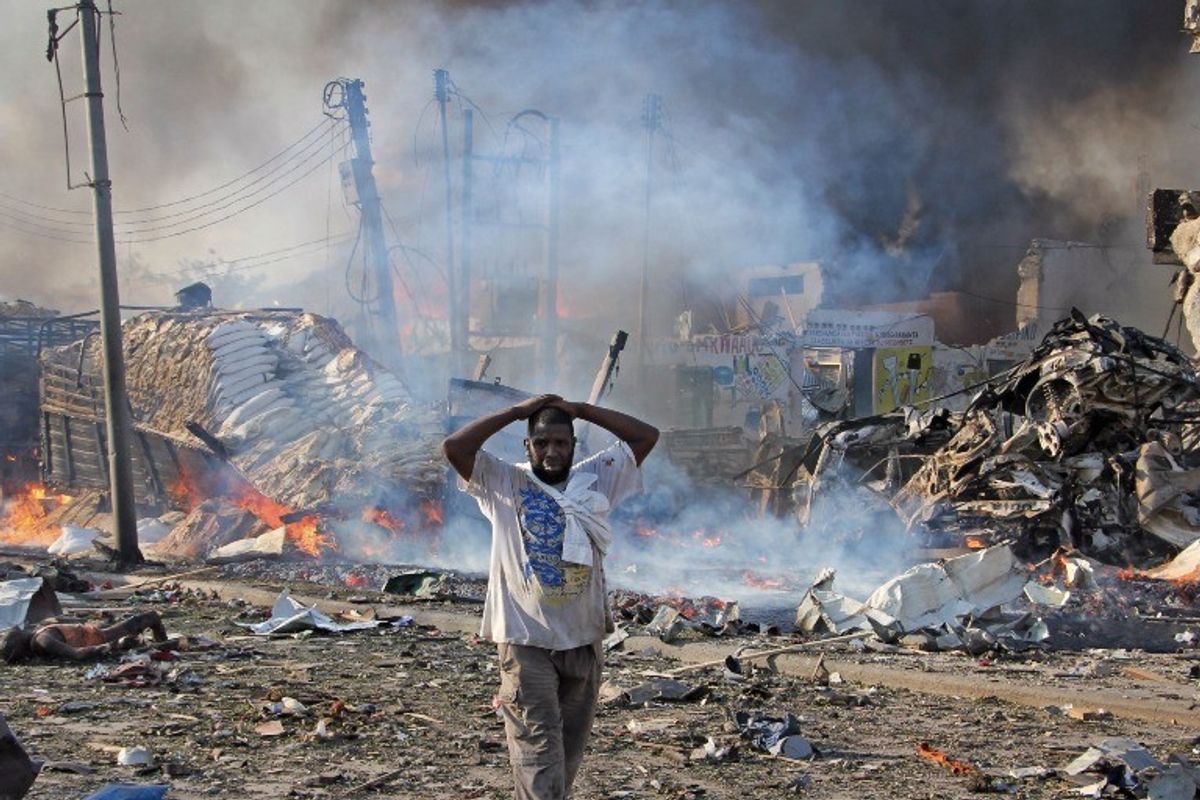The multinational peacekeeping force known as AMISOM has been losing the momentum in its battle against al Shabaab in Somalia, as evidenced by the massive Oct. 14th truck bomb that killed more than 350 people in the capital Mogadishu. While AMISOM – the African Union Mission in Somalia – was initially successful in rooting out the group from southern Somalia, it can’t address the root cause that has given al Shabaab purchase on the population: a weak Somali central government that is still unable to provide services or security to its people.
- Somalia’s struggle with Islamist insurgencies dates back to the early 1990s when the country broke out into civil war.
- Al Shabaab, meaning “the youth,” was formed in 2006, was designated by the U.S. State Department as a Foreign Terrorist Organization in March 2008, and officially pledged allegiance to al Qaeda in 2012.
AMISOM has been spearheading the campaign against al Shabaab since its establishment in January 2007. A regional peacekeeping mission comprised of forces from Burundi, Djibouti, Ethiopia, Kenya, Uganda, Ghana, Nigeria and Sierra Leone, AMISOM was initially granted a six-month mandate by the UN and the African Union’s Peace and Security Council to provide stability in Somalia and support the country’s national reconciliation government.
- The mission’s tenure has been consistently extended over the course of the last decade as Somalia’s central government has been mired in political turmoil, and the Somali military has failed to ameliorate a deteriorating security situation.
- In mid-August, the United Nations authorized AMISOM to maintain troops in Somalia until June 2018 but required it to reduce its personnel in the country to a maximum of 21,626 by the end of this calendar year.
- According to AMISOM’s mandate, its main objectives include reducing the threat posed by Al Shabaab by conducting operations against the terrorist organization, providing security to enable the political process in Somalia as well as to focus on stabilization efforts, reconciliation and peacebuilding in the country, and enabling the gradual handing over of security responsibilities from AMISOM to the Somali security forces.
During its first five years, AMISOM did achieve a certain level of success in the battle against al Shabaab.
Ambassador James C. Swan, U.S.
Ambassador to the Democratic Republic of the Congo
“Between 2007 and 2012, AMISOM largely achieved its core objectives. AMISOM forces secured the Transitional Federal Government (TFG), allowing time for needed changes in leadership and then the replacement of the TFG by a new Federal Government of Somalia. AMISOM troops recaptured much of Southern Somalia that had been administratively controlled by al Shabaab, gradually extending the government’s presence from what as late as 2010 was still just a toe-hold in Mogadishu.”
By 2012, AMISOM had managed to push al Shabaab out of its major strongholds in southern Somalia, including the port city of Kismayo, where the group had established its de facto capital, leading analysts to conclude that al Shabaab was on the brink of defeat.
Grant Harris, Former Special Assistant to the President and Senior Director for African Affairs
“It is a testament to the region that AMISOM has been as successful as it has in combating al Shabaab. I recall years ago when the Somali transitional government controlled only a few city blocks in Mogadishu. Since that time, regional forces have increased the strength and success of AMISOM and given a new government the chance to start building its security institutions.”
Nevertheless, al Shabaab managed to rebound and transform into an enduring regional threat. Since the group vacated Kismayo, it has carried out regular, large-scale attacks against military and civilian targets throughout the Horn of Africa, including the September 2013 shooting spree at the Westgate Mall in Nairobi, Kenya, which left 68 people dead and 175 wounded, and the April 2015 massacre at Kenya’s Garissa University, which left nearly 150 people dead.
Cheryl Sim, Former Foreign Affairs Advisor to the Combined Joint Task Force - Horn of Africa
“There continues to be a misperception that AMISOM and the SNA defeated al Shabaab in Mogadishu in August 2011 during what was referred to at that time as the Ramadan offensive. Rather than being defeated in the traditional sense on the battle field, al Shabaab made a tactical decision to withdraw its forces from the city instead of continuing to try to hold territory through conventional fighting.”
Today, AMISOM is confronted with the same challenge it faced during its inception: how to prop up a weak central Somali government while simultaneously battle an escalating terrorist adversary. This daunting task, combined with a recent uptick in the number of al Shabaab-orchestrated attacks, has tarnished AMISOM’s accomplishments over the years.
Cheryl Sim, Former Foreign Affairs Advisor to the Combined Joint Task Force - Horn of Africa
“AMISOM has also been hampered by unrealistic expectations placed on it by Somalis and the international community to engage in governance activities, including civic action and other humanitarian type activities, that should be the purview of the Federal Government of Somalia and the regional governments. The mission is not equipped or funded to carry out these activities.”
In essence, AMISOM’s battlefield successes have been undercut by the failure of the Somali central government to exert authority, provide critical services and win the hearts and minds of the local Somali population.
- The continued deployment of foreign troops in Somalia through AMISOM, including from country’s that have previously clashed with Somalia, such as Ethiopia, has sparked some tension in Somalia, which al Shabaab has incorporated into its propaganda. An opportunistic organization, “Al Shabaab has always played upon the pragmatic, local and political equation to survive and operate,” Bronwyn Bruton, Deputy Director of the Atlantic Council’s Africa Center, told the Cipher Brief last month.
- For AMISOM to ultimately achieve its objective of facilitating peace and stability in Somalia, the solution does not solely reside in military operations. AMISOM’s presence in Somali has offered some semblance of stability, but it ultimately remains in the hands of the Somali central government to shoulder the burden to achieve a lasting peace.
Ambassador James C. Swan, U.S.
Ambassador to the Democratic Republic of the Congo
“AMISOM is bedevilled by the challenges that confront any fighting force in a protracted counter-insurgency campaign: ultimately the keys to victory are political and developmental, not just military. Since its inception, AMISOM’s mission has afforded time and space for Somalis to build effective military, police and intelligence capacity that could protect government administration in areas recaptured from al Shabaab. Yet, efforts to bolster Somali security forces have been hindered by sluggish cooperation between the central government and the federated states, and by insufficient alignment and coordination among external security partners. Meanwhile, even in areas they hold, the central government and federated states struggle to administer territory, provide basic services and overcome a decades-long legacy of corruption and mismanagement of state institutions. These weaknesses create openings that al Shabaab continues to exploit.”
Bennett Seftel is deputy director of analysis at The Cipher Brief. Follow him on Twitter @BennettSeftel.












